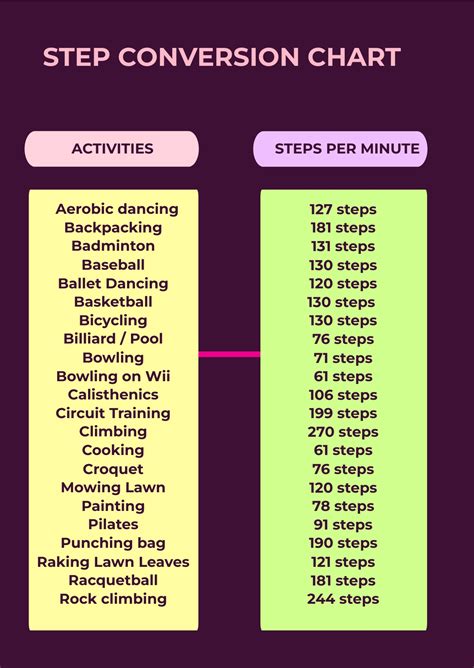Intro
Convert daily steps to miles with our guide, exploring 10,000 steps to miles, step tracking, and distance measurement for a healthier lifestyle.
The idea of taking 10,000 steps a day has become a widely accepted goal for improving overall health and fitness. This concept originated in Japan in the 1960s, where it was marketed as a way to promote physical activity and reduce the risk of chronic diseases. But have you ever wondered how far 10,000 steps actually is? In this article, we will explore the relationship between steps and miles, and provide you with a better understanding of what it means to reach this daily goal.
Taking 10,000 steps a day can have a significant impact on your physical and mental health. Regular walking can help to reduce the risk of heart disease, type 2 diabetes, and some types of cancer. It can also improve your mood, boost your energy levels, and even help you to manage your weight. But for many people, the idea of taking 10,000 steps a day can seem daunting, especially if they are not used to being physically active. By understanding how far 10,000 steps is, you can set more realistic goals and track your progress more effectively.
The relationship between steps and miles is not always straightforward, as it depends on the length of your stride. On average, a person's stride length is about 2.5 to 3 feet, which means that it takes around 2,000 to 2,500 steps to walk one mile. However, this can vary significantly from person to person, depending on their height, weight, and walking style. To give you a better idea, here are some approximate conversions: 10,000 steps is equivalent to about 4 to 5 miles, depending on your stride length.
Understanding the Relationship Between Steps and Miles

Factors That Influence Stride Length
There are several factors that can influence your stride length, including: * Height: Taller people tend to have longer stride lengths, as they have longer legs and can cover more distance with each step. * Weight: People who are overweight or obese may have shorter stride lengths, as they may have more difficulty moving their legs and covering distance. * Walking style: People who walk with a more efficient gait, such as those who keep their posture upright and their feet striking the ground midfoot or forefoot, may have longer stride lengths. * Fitness level: People who are more physically fit may have longer stride lengths, as they have stronger muscles and better cardiovascular endurance.Converting Steps to Miles

Using a Pedometer or Fitness Tracker
One of the easiest ways to track your steps and convert them to miles is to use a pedometer or fitness tracker. These devices can be worn on your wrist or clipped to your belt, and they use sensors to track your movements and calculate your step count. Many pedometers and fitness trackers also have built-in converters that can translate your steps into miles, making it easy to track your progress and set realistic goals.The Benefits of Taking 10,000 Steps a Day

Tips for Reaching Your Daily Step Goal
Reaching your daily step goal can be challenging, especially if you have a sedentary job or lifestyle. Here are some tips to help you get started: * Start small: If you're new to walking, start with a smaller goal, such as 5,000 steps a day, and gradually increase your target over time. * Find a walking buddy: Having someone to walk with can make the experience more enjoyable and help you to stay motivated. * Schedule it in: Treat walking as a non-negotiable part of your daily routine, such as brushing your teeth or taking a shower. * Mix it up: Vary your walking routine to avoid boredom and prevent plateaus. Try walking in different locations, such as parks or trails, or incorporating strength training or high-intensity interval training into your routine.Overcoming Obstacles and Staying Motivated

Common Obstacles and How to Overcome Them
Here are some common obstacles that people face when trying to reach their daily step goal, along with some tips for overcoming them: * Lack of time: Try to incorporate walking into your daily routine, such as by taking a walk during your lunch break or after dinner. * Lack of motivation: Find a walking buddy or join a walking group to provide support and motivation. * Inclement weather: Try walking indoors, such as on a treadmill or at a shopping mall, or invest in waterproof gear to walk outdoors in rainy or snowy weather.Conclusion and Next Steps

Final Thoughts and Recommendations
Here are some final thoughts and recommendations to help you get started on your walking journey: * Consult with a healthcare professional: Before starting any new exercise routine, it's essential to consult with a healthcare professional, especially if you have any underlying health conditions. * Invest in a good pair of walking shoes: A good pair of walking shoes can make a significant difference in your comfort and performance. * Stay hydrated: Make sure to drink plenty of water before, during, and after your walks to stay hydrated and prevent dehydration.What is the average stride length for an adult?
+The average stride length for an adult is about 2.5 to 3 feet, although this can vary significantly from person to person.
How many steps are in a mile?
+There are approximately 2,000 to 2,500 steps in a mile, depending on your stride length.
What are the benefits of taking 10,000 steps a day?
+Taking 10,000 steps a day can help to improve your cardiovascular health, manage your weight, improve your mental health, and increase your energy levels.
We hope this article has provided you with a better understanding of the relationship between steps and miles, and has inspired you to start your walking journey. Remember to stay motivated, track your progress, and overcome obstacles to achieve your goals. Share your thoughts and experiences in the comments below, and don't forget to share this article with your friends and family to inspire them to start walking too!
